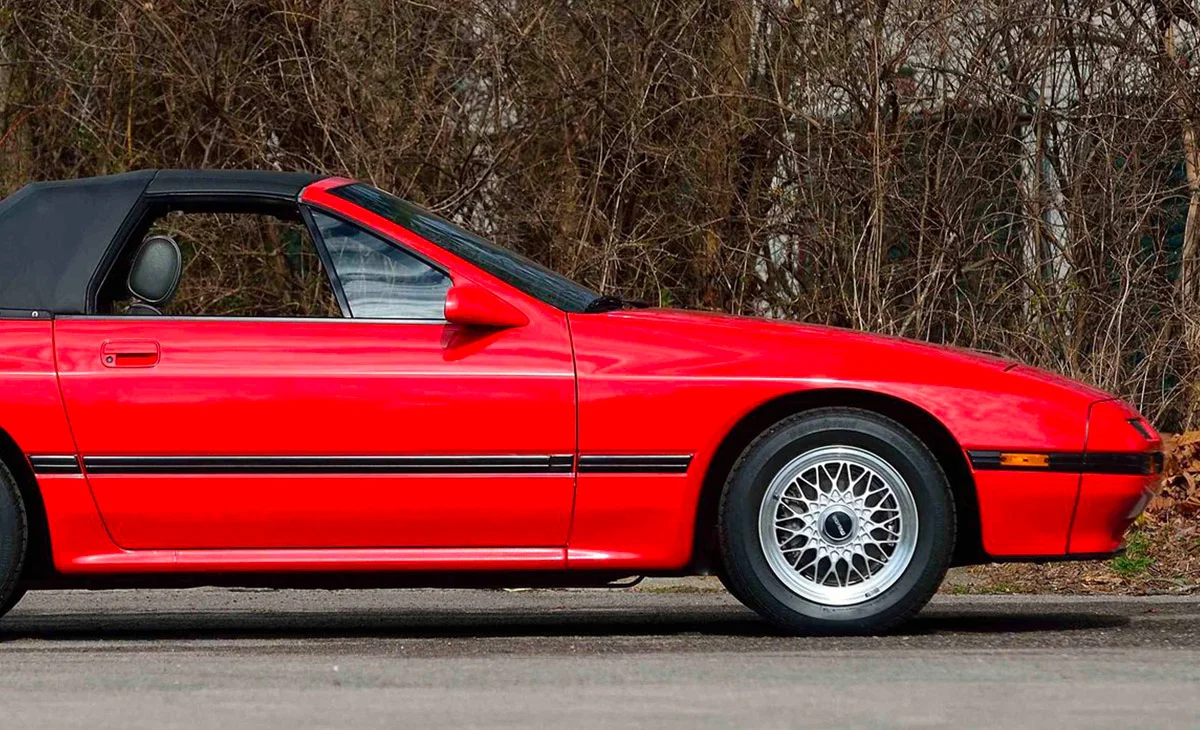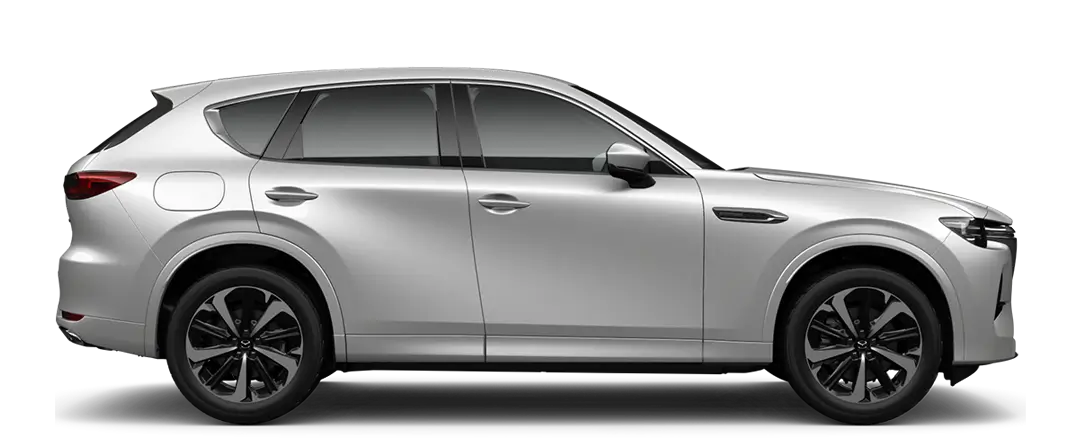2nd Gen Mazda RX-7
November 10, 2022 9:54 am
A completely new look!
Launched in 1985, the second generation of the RX-7 (“FC” or Savanna RX-7 in Japan), featured a complete restyling much like similar sports cars of the era such as the Nissan 300ZX. Mazda’s development team, led by Chief Project Engineer Akio Uchiyama, chose to focus on the American market when designing the FC, where the majority of first-generation RX-7 models had been sold. The team drew inspiration from successful sports cars that were popular at the time, such as studying the suspension design of the Porsche 928. While the SA22C (1stGen RX-7) was a purer sports car, the FC tended toward the softer sport-tourer trends of its day, sharing some similarities with the HB series Cosmo. Handling was much improved, with less of the oversteer tendencies of the SA22C. The rear end design was vastly improved from the SA22C’s live rear axle to a more modern, Independent Rear Suspension (rear axle). Steering was more precise, with rack and pinion steering replacing the old recirculating-ball steering of the SA22C. Disc brakes also became standard, with some models offering four-piston front brakes. The 13b twin rotor was available as naturally aspirated or as a turbo depending on the model and market. Customers could choose between a 5-speed manual or a 4-speed automatic transmission.

Innovation
Mazda also introduced Dynamic Tracking Suspension System (DTSS) in the FC. The revised independent rear suspension incorporated special toe control hubs which were capable of introducing a limited degree of passive rear steering under cornering loads. The DTSS worked by allowing a slight amount of toe-out under normal driving conditions but induced slight toe-in under heavier cornering loads at around 0.5g or more; toe-out in the rear allows for a more responsive rotation of the rear, but toe-in allowed for a more stable rear under heavier cornering. Another new feature was the Auto Adjusting Suspension (AAS). The system changed damping characteristics according to the road and driving conditions. The system compensated for camber changes and provided anti-dive and anti-squat effects.

Limited Edition – Infini (Japan Only)
In Japan, a limited edition of the FC called Infini was available with production limited to only 600 cars for each year. Some special noted features for all Infini series are the Infini logo on the rear, upgraded suspension, upgraded ECU, the higher power output of the engine, lightened weight, 15-inch BBS aluminum alloy wheels, Infini logo steering wheel, aero bumper kits, bronze coloured window glass, floor bar on the passenger side, aluminum bonnet with scoop, flare, and holder. The car was thought of as the pinnacle of the RX-7 series (until the introduction of the FD). The Infini IV came with other special items such as black bucket seats, 16-inch BBS wheels, Knee pads, and all the other items mentioned before.

Turbo!
The Turbo II model uses a turbocharger with a twin-scroll design. The smaller primary chamber is engineered to cancel the turbo lag at low engine speeds. At higher revolutions, the secondary chamber is opened, pumping out 33 percent more power than the naturally aspirated counterpart. The Turbo II also has an air-to-air intercooler which has a dedicated intake on the hood. The intake is slightly offset toward the left side of the hood. In the Japanese market, only the turbocharged engine was available; the naturally-aspirated version was only available for select export markets. This can be attributed to insurance companies in many Western nations penalising turbocharged cars (thus restricting potential sales). The Japanese market car produces 185 PS (136 kW) in the original version; this engine was upgraded to 205 PS (151 kW) in April 1989 as part of the Series 5 facelift. The limited edition, two-seater Infini model received a 215 PS (158 kW) version beginning in June 1990, thanks to an upgraded exhaust system and high-octane fuel.
Australian Motors Mazda introduced a limited run of 250 ‘Sports’ model Series 4 RX-7s; each with no power steering, power windows or rear wiper as an attempt to reduce the weight of the car.
Convertible – 1988 Mazda RX-7 convertible (FC)
Mazda introduced a convertible version of the RX-7, the FC3C, in 1988 with a naturally aspirated engine. The convertible featured a removable rigid section over the passengers and a folding fabric rear section with a heated rear glass window. Power-operated, lowering the top required unlatching two header catches, power lowering the top, exiting the car (or reaching over to the right side latch), and folding down the rigid section manually. Mazda introduced with the convertible the first integral wind-blocker, a rigid panel that folded up from behind the passenger seats to block unwanted drafts from reaching the passengers—thereby extending the driving season for the car with the top retracted. The convertible also featured optional headrest-mounted audio speakers and a folding leather snap-fastened tonneau cover. The convertible assembly was precisely engineered and manufactured and dropped into the ready body assembly as a complete unit—a first in convertible production. Production ceased in 1991 after Mazda marketed a limited run of 500 examples for 1992 for the domestic market only. In markets outside the US, only the turbocharged version of the convertible was available.

10th Anniversary RX-7
Mazda introduced the 10th Anniversary RX-7 in 1988 as a limited production model based on the RX-7 Turbo II. Production was limited to 1,500 units. The 10th Anniversary RX-7 features a Crystal White (paint code UC) monochromatic paint scheme with matching white body side mouldings, tail light housings, mirrors, and 16-inch alloy seven-spoke wheels. A distinctive 10th Anniversary package feature is the all-black leather interior, which included not just the seats, but the door panel inserts as well as a leather-wrapped MOMO steering wheel (with 10th Anniversary Edition embossed horn button) and MOMO leather shift knob with an integrated boot. All exterior glass is bronze tinted (specific in North America to only the 10th Anniversary), and the windshield was equipped with the embedded secondary antenna also found on some other select models with the upgraded stereo packages. Other 10th Anniversary Edition-specific items were headlight washers, glass breakage detectors added to the factory alarm system, 10th Anniversary Edition logoed floor mats, 10th Anniversary Edition embroidered front hood protector and accompanying front end mask (or “bra”), and aluminum under the pan.

Super Rare GTUs (1989–1990)
In 1989 Mazda introduced a limited model labeled the GTUs. Starting with the lightweight base model, which came with manual windows, no rear wiper, the sunroof and A/C was dealer optioned, the GTUs added items found on the Turbo model such as four-piston front brakes, ventilated rear brake rotors, vehicle speed-sensing power steering, one-piece front chin spoiler, cloth-covered Turbo model seats, leather-wrapped steering wheel, 16-inch wheels, 205/55VR tyres, and a GTUs-only 4.300 viscous-type limited-slip differential (all other FC LSD’s were 4.100). This allowed quicker acceleration from the non—turbo-powered 13B. It was rumoured that Mazda built 100 cars in 1989–1990.

Continuing the rotary’s success
A total of 272,027 Mazda 2ndGen RX-7 FCs were built. With head-turning good looks, mechanical innovation, and the introduction of a convertible the 2ndGen RX-7 proved to be a popular and iconic car. Ending production in 1992, the FC continued the success enjoyed by the 1stGen RX-7 (SA22C, FB) but also paved the way for one of Mazda’s most iconic cars ever, the 3rdGen Mazda RX-7 (FD) later in 1992.














